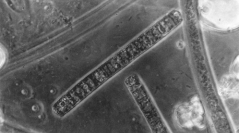

 Cryptogamie, Algologie
24 (4) - Pages 307-321
Cryptogamie, Algologie
24 (4) - Pages 307-321The morphology of the common and widely distributed calcite-encrusted cyanobacterium Phormidium incrustatum (Näg.) Gomont is redescribed. Numerical analysis indicated that the species was conservative for trichome width and cell length but not for end cell characteristics. Phormidium incrustatum colonised travertine (calcium carbonate deposits) in alkaline streamwaters,low in dissolved orthophosphate but high in nitrate-nitrogen. Stream sites were often surrounded by trees,and a bimodal seasonal illumination regime occurred. Biomass,measured as biovolume,was low for this species, averaging 0.28 mm3 cm-2 and resulted from the low illumination regime imposed by calcite deposition and tree shading. No significant correlation was found between the biomass of Phormidium and rate of travertine deposition,and the taxonomic value of calcification in this cyanobacterium is questioned. The species has a worldwide distribution currently spanning latitudes 54o N to 30o S. It is common on shaded spring-deposited travertine,and in the encrusted littoral zone of calcareous lakes. In some populated regions,the species has been lost as a result of water pollution or channel modification.